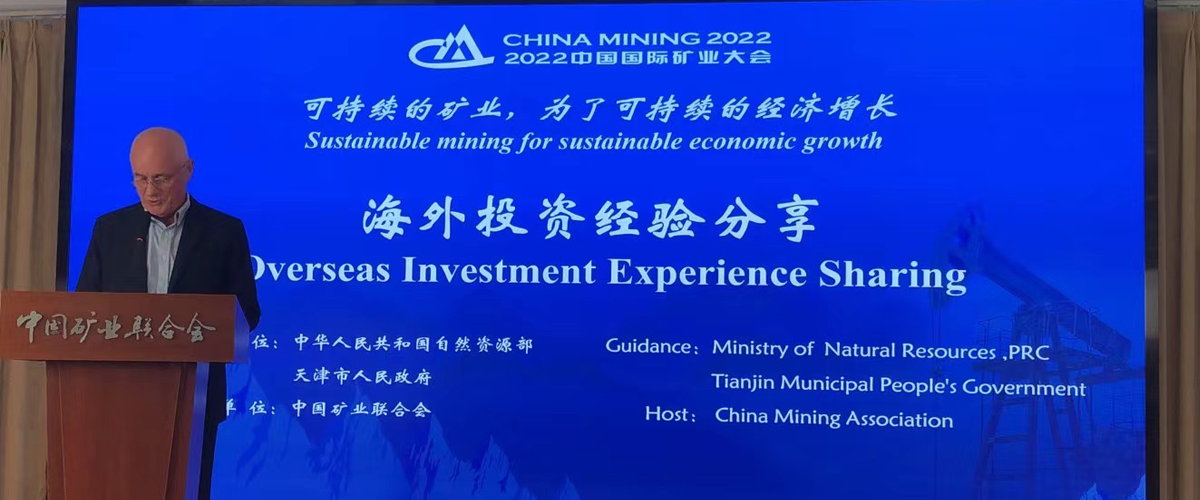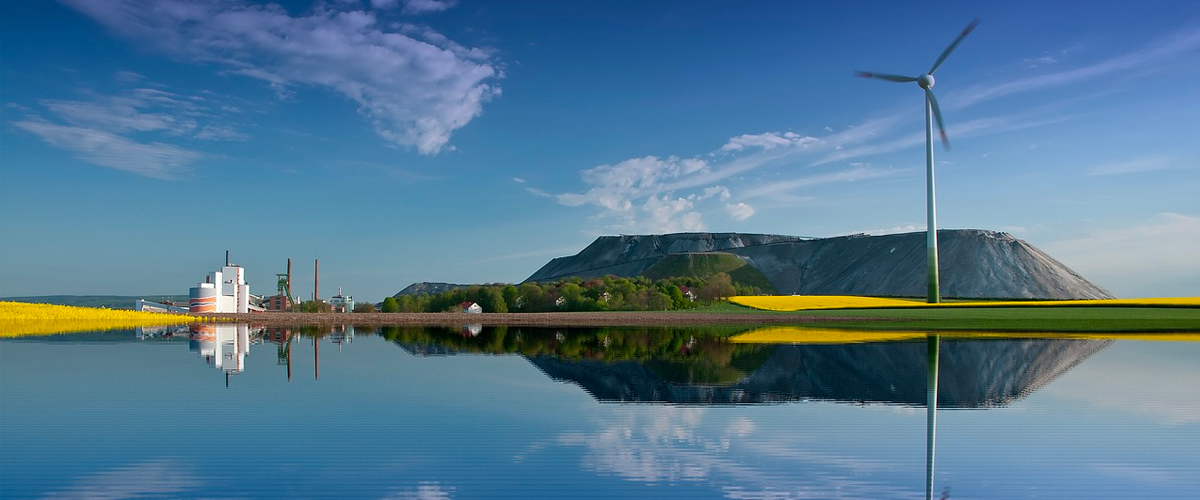| Peter Arkell

"Lessons from International Mining Company Experience in China"
China Mining Conference 2022 - Peter Arkell, Chairman GMAC. 22nd September 2022
Mr Peter Arkell gave the following speech:
Thank you very much for giving me the opportunity to contribute to this China Mining Conference Overseas Investment Experience Sharing Forum. It’s an honour to be here representing GMAC with such experienced panelists.
Although, it is striking that we are discussing overseas investment by Chinese companies at an online China Mining conference because travel is so difficult in these Covid times.
For those who do not know GMAC, it is the Global Mining Association of China, and it is the representative body of the international mining community here. Our members include mining companies as well as companies from the broad mining sector such as bankers, lawyers, equipment manufacturers, consultants, foreign government agencies and many others. We meet each month, usually in Beijing, discussing industry matters of interest as well as taking the time to catch up over a glass or two of wine. Our good friends at the China Mining Association often join us and CMA members are always welcome. In fact, this evening we will be hosting the Peru Ambassador to China at our September GMAC meeting. He will be discussing the mining industry in his country.
As you heard, I am the Chairman of GMAC.
I thought that a good place to start my remarks about China’s overseas investment experience, would be to take a look back in time at the foreign direct investment into China’s domestic mineral development.
When I first joined GMAC in the early 2000’s there was an unbelievably vibrant mining community which was dominated by mining companies enthusiastically exploring for a wide range of minerals including gold, nickel, coal, iron ore, zinc, silver and even diamonds. All of the major mining companies had significant presence here, and there were mid-caps and even junior exploration companies that had raised capital abroad with the sole purpose of developing single projects in China. Among our group, there were more than 400 projects with exploration underway.
I recall that there were also a number foreign companies that had successfully transitioned from exploration to mining licenses. There was Sino Gold producing gold obviously, Griffin Mining producing zinc, Afcan Mining, which was acquired by Eldorado producing gold, London Mining producing iron ore and Continental Minerals with a copper project in Tibet. They were heady days.
China Mining Conferences were a big deal and dominated by the international mining community. My first China Mining in 2005 was in the Beijing Hotel and it then moved to the international conference centre in Beijing before it moved to Tianjin. In those early days, the main hall was dominated by the foreign companies and there was a smattering of Chinese miners in an annex off the main hall.
At the China Mining Conference in 2009 I gave a paper on a very similar topic, as part of a panel that was looking at the challenges facing foreigners coming into China and the models that might be adopted by Chinese miners considering to go abroad.
At that time the examples were CITIC Pacific’s magnetite project in Western Australia and MinMetals’ acquisition of most of the OZ Minerals assets to form MMG.
How things have changed since those days less than 15 years ago.
Today there is only Griffin Mining as a foreign mining company producing in China and exploration has shrunk from that high water mark of 400 projects to less than a handful, mainly restricted to a joint venture between Rio Tinto and MinMetals and exploration by Griffin. In the same period China’s demand for all sorts of minerals created the biggest “mining boom” that the industry has experienced. In 2001 the price of a ton of iron ore was only $12, and this year it broke through the $200 per ton mark.
Chinese demand caught producers drastically short of capacity and prices soared as a result. And Chinese buyers were left with few options other than to be a “price taker”.
In observing this incredible boom in prices, GMAC asked two leading industry analysts, Jim Marron and Nigel Rockliffe to look at how China might transition from “Price Taker to Price Maker”. When they presented their paper in 2013, the “mining boom” was well underway.
Marron and Rockliffe’s paper said:
"The enormous size of the Chinese market gives them the commercial strength to act where smaller countries could not.
Chinese buyers and producers are adopting different strategies to suit the circumstances of each resource sector. But the rationale is the same: Never again.
In some cases, they will seek to acquire equity in existing off-shore mines and processors. Alternatively, they will seek to construct mineral processing capacity onshore and, if the economic and political arguments are compelling enough, off-shore as well. A reason for doing the latter is to gain access to off-shore deposits by undertaking to value-add locally.
In other cases, they will seek to utilise formerly unviable domestic resources. In this regard, Chinese operators have demonstrated that they are adept and inventive in finding and adapting technological solutions to solve current problems. They also have an impressive record of constructing facilities speedily and cheaply.”
And as today’s panel topic indicates, there are now many Chinese companies invested in mining operations around the world. I am so impressed by the Chinese leaders that I have met or observed who are steering this international activity by Chinese mining companies. In my opinion they are every bit as smart, incisive, savvy as any of their contemporaries in the foreign mining community.
But it does beg one question. The world’s major mining companies are still the foreign companies such as BHP, Rio Tinto, Vale, AngloAmerican, Glencore. When will there be a Chinese mining company among this group of giant diversified miners?
In other industries, like banking or technology, there is often a “China Champion”. Will we see a “China Mining Champion” emerge as these companies continue to develop projects to meet the domestic demand for commodities? Who will it be?
Just for a moment, I would like to bring a GMAC initiative to the attention of all those Chinese companies looking to invest in mineral projects abroad.
GMAC, in association with the AusIMM, has developed a JORC Code training program that is delivered in Mandarin by Chinese mining industry professionals. It is a program that should be undertaken by all staff involved in project acquisitions. It is suitable for all team members of the investment project including BD, legal, finance professionals as well as the geologists.
There is an online version and my favorite is the option of conducting in-house face-to-face training for your company.
Now, after that “GMAC ad break”, back to the current situation.
With the recent establishment of the China Minerals Resources Group, China has made it clear that it wants to have a stronger hand in the price paid for minerals, starting with iron ore which burst through the $200 per ton, peaking in March this year at around $230. Remember how it was only $12 a ton 20 years ago.
There might have been concerns among the major producers when this giant buyer organization was established. But after discussions early this month with Rio Tinto’s CEO Jakob Stausholm, the Chairman of China Minerals, Yao Lin was reported to have said that the Group is willing to establish a strategic partnership with Rio Tinto and to work on a win-win and sustainable supply chain to support China’s steel industry.
To their credit, Rio Tinto has been demonstrating several ways that Chinese interests can cooperate with the mining majors. In the Simandou iron ore deposit in Guinea, it has recently announced that Rio Tinto/Chinalco will join with the Chinese consortium holding the other significant Simandou tenement to develop the necessary rail and port infrastructure to bring that huge iron ore resource to life.
And here in China there is Rio’s significant exploration joint venture with MinMetals.
In fact, there is a long history of Rio Tinto cooperating with Chinese interests abroad. In 1987 the Channar iron ore project in Western Australia was established between Rio Tinto and Sinosteel. That extremely successful 60:40 joint venture was a pioneer example of what’s possible and it has only just completed its life after 35 years. How farsighted were those officials in both companies when they put that deal together.
But it’s not all about iron ore, as significant as that might be for China’s industry. For example, Huayou Cobalt has just announced a deal with Vale’s Indonesian nickel unit to build a plant to refine metal for use in EV batteries.
At a recent Antaike China Battery Minerals conference in DeZhou, Deputy Secretary General of the China Non-Ferrous Metals Industry Association, Hu Changping, said that China depends on overseas sources for 93% of its nickel, 98% of its cobalt, and 65% of its lithium. So, it’s no wonder that we are having this discussion about China’s Overseas Investment in Mining.
What a shame that China Mining 2022 is an online event. I thought “what a party we should be having this year”, when I saw the headline on the front of a newsletter published by The China Project this month. “The Only Profits in China are Mining Profits”!!!
The article went on to say, “lithium and silicon miners are enjoying windfalls thanks to the electric vehicle and solar energy industries, as well as copper and uranium mining being lucrative too”.
The article said that China’s manufacturing is down 12.6% year-on-year. While in mining the price of lithium carbonate has gone from RMB40,000 per ton only two years ago, to be hitting RMB503,000 per ton this April. High Purity Silicon has hit RMB300,000 per ton. Chinese mining companies are leaders in these products.
I remember in an address to a recent GMAC meeting, HuaYou Cobalt Vice Chairman and our good friend Fang QiXue said that “nickel is the new gold”.
The Chinese mining companies have been very wise in their strategic approach to acquiring international assets in the important key minerals.
Of course, Chinese companies, like any miner, will be well advised to follow the four guiding pillars that CMA President Peng QiMing has been advocating for some time.
- Safety
- Green
- Innovation
- Integration
These pillars make sense domestically as well as in any international project. In fact, these also match the criteria expected of the international mining community and any multi-national company would be severely marked down by the capital markets if it did not hit these standards.
Dr Peng spoke at a GMAC meeting only a month or so ago and he drew our attention to these four pillars. And it reminded me of remarks made by the then Chairman of MMG Wang Lixing at a large industry dinner that we hosted in Shanghai some years ago. He said:
“At its simplest, overseas investment is a partnership. It is a partnership between companies and most importantly between different cultures and people. Chinese business has the financial reserves, the market demand, and the entrepreneurship to be looking for global opportunities.
Where we listen, where we are open and transparent, where we respect and value local communities, employees, and management, and where we look for win-win opportunities – we can build great partnerships”.
I reflected earlier in this paper on the early 2000’s when there were so many foreign mining companies here in China.
In my day job, I’m a headhunter in the mining sector. I saw that a major challenge for those foreign companies that were setting up here was to be aware of the cultural differences. Not just the business and social culture of China but also to accept that there is a special culture that existed in head office. We would talk about the need for people “adaptors”, just like you need adaptors for your laptop and your phone when you go abroad, to help the company and its people to manage these complex culture issue.
In those days companies highly valued Chinese professionals with deep international experience, like Returnees, “Hai Gui”, or people who had built careers here in international companies.
Watching the Chinese mining companies going abroad, there have been examples of them hiring senior western executives in order to bring that perspective of international expertise. Often, it’s not easy for the company or for the western executives that come on board. Things can become especially difficult when commodity prices fluctuate, and projects come under cost pressure when there is a slump.
This is just the time when the wisdom that comes from experience can be most beneficial. However, regrettably, it has been in these demand and price slumps that I have observed Chinese companies often jettison those foreign executives as a cost reduction strategy. Of course, as cycles always do, the price recovers and the experience and the international awareness has been lost for the next growth phase.
Speaking of cycles, I would like to come back to an observation that I made at the beginning of my talk. There was a time when we had just about every major and mid-cap mining company here running hundreds of exploration projects. They saw the huge potential of the domestic mining opportunities. Yet today there are less than a handful engaged in the local mining scene.
At the same time there has been enormous success in Chinese miners going abroad; even if we haven’t yet crowned a “Chinese Champion”. There are Chinese mining assets across Asia, Africa, Australia, South America, North America, Europe. I take my hat off to companies such as Zijin, MinMetals, Jinchuan, CMOC, Chinalco, Wanbao, Qingshan, HuaYou, Tianqi, Yanzhou, CITIC Pacific and many others. This is a tough business and I admire all Chinese miners who have made overseas investments and shown the industry that they have the talent and the commitment to succeed globally.
A word that recurs many times at GMAC meetings among the old mining hands here is “reciprocity”.
Wouldn’t it be great to see international miners given the same level of access here in China, bringing mining assets to life just as the Chinese have done abroad? We could then have a truly international mining scene on the ground here that can be a platform for even greater international success.
We are part of a wonderful global industry that continues to evolve. I know of no other industry that brings its people together so easily and so constructively. It has been my honour to be a part of the dialogue at China Mining 2022.
To find out more please contact: admin@carringtonday.com



